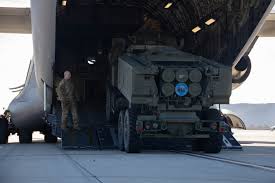Today, I RT this @WSJ article on logistics challenges w/in Ukraine.
It generated a bunch of "but what about..." from many who may not understand what goes into decisions related to delivering weapons to allies/partners.
So here's a 🧵on that. 1/
wsj.com/articles/many-…
It generated a bunch of "but what about..." from many who may not understand what goes into decisions related to delivering weapons to allies/partners.
So here's a 🧵on that. 1/
wsj.com/articles/many-…
The @DeptofDefense is focused on planning & analysis as an organization for decision-making.
Each decision is based on a variety of practical & national security considerations.
As citizens concerned primarily about our own national security, we expect nothing less. 2/
Each decision is based on a variety of practical & national security considerations.
As citizens concerned primarily about our own national security, we expect nothing less. 2/

When an ally or partner (like Ukraine) requests support - weapons, ammunition, military manpower, etc - there are no rash decisions.
The requests are analyzed, weighed against multiple factors, assessed, and then military & civilians make recommendations to the @SecDef. 3/
The requests are analyzed, weighed against multiple factors, assessed, and then military & civilians make recommendations to the @SecDef. 3/

When a country asks for "X," here are just *some* of the things that weigh into the analysis:
-Do we have x?
-Do we have enuf of x to provide it w/o putting US security (& contingency plans) at risk?
-How is the partner going to use x?
-Is there an alternative system to x? 4/
-Do we have x?
-Do we have enuf of x to provide it w/o putting US security (& contingency plans) at risk?
-How is the partner going to use x?
-Is there an alternative system to x? 4/

-How much does x cost?
-What are the logistical & maintenance requirements for x?
-Can the partner provide log/maintenance support for x (or will they need US support/contractors)?
-What's the possibility that foes would gain information about x that may harm our security?
5/
-What are the logistical & maintenance requirements for x?
-Can the partner provide log/maintenance support for x (or will they need US support/contractors)?
-What's the possibility that foes would gain information about x that may harm our security?
5/

-What are the long-term costs/recurring costs of providing x?
-If x comes from reserve/national stockpiles, what is the timeline for replenishment?
-If x is a piece of equipment, do we have adequate ammo supplies to support its use given rates of fire? 6/
-If x comes from reserve/national stockpiles, what is the timeline for replenishment?
-If x is a piece of equipment, do we have adequate ammo supplies to support its use given rates of fire? 6/

-Can our industrial base support the transfer of x to the partner with ammo, parts, maintenance?
-What is the training program to support transfer of x?
-Does the transfer of x meet @POTUS guidance & is it acceptable to Congress (& the American people)? 7/
-What is the training program to support transfer of x?
-Does the transfer of x meet @POTUS guidance & is it acceptable to Congress (& the American people)? 7/

These questions are a sample of what is analyzed by those who are:
-experts in tactical application of weapons
-logistical support of equipment
-understanding of stockpiles & supply chains
-operational requirements & other national security commitments/global contingency plans.8/
-experts in tactical application of weapons
-logistical support of equipment
-understanding of stockpiles & supply chains
-operational requirements & other national security commitments/global contingency plans.8/

Wait...we're not done!
After all this analysis is conducted, it's time for a decision.
Civilians & military experts then take "The Book" to the @SecDef. They brief him on the various pros/cons of providing x, and he makes the decision. The item is provided...or not. 9/
After all this analysis is conducted, it's time for a decision.
Civilians & military experts then take "The Book" to the @SecDef. They brief him on the various pros/cons of providing x, and he makes the decision. The item is provided...or not. 9/

Truthfully, this is what all successful businesses do when making decisions...except with these decisions there are several other factors:
US National Security.
Life & death scenarios.
Support for allies/partners.
Yeah, a bit tougher than what most businesses do. 10/
US National Security.
Life & death scenarios.
Support for allies/partners.
Yeah, a bit tougher than what most businesses do. 10/
I am a huge supporter of Ukraine's fight for sovereignty & I want to see them beat the RU as soon as possible.
But having once been involved in taking "The Book" to the SecDef during a time of war, I also know there are many considerations that go into these decisions.11/
But having once been involved in taking "The Book" to the SecDef during a time of war, I also know there are many considerations that go into these decisions.11/

This process is deliberate decision making. It's used by most militaries in the world.
It's a prudent method to ensure US national security WHILE also helping our allies.
UKR will want many things. The US (& @NATO) will find the best way to help. 12/
It's a prudent method to ensure US national security WHILE also helping our allies.
UKR will want many things. The US (& @NATO) will find the best way to help. 12/

• • •
Missing some Tweet in this thread? You can try to
force a refresh















